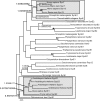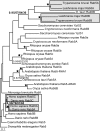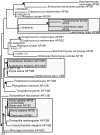Phylogeny of endocytic components yields insight into the process of nonendosymbiotic organelle evolution
- PMID: 18182495
- PMCID: PMC2206580
- DOI: 10.1073/pnas.0707318105
Phylogeny of endocytic components yields insight into the process of nonendosymbiotic organelle evolution
Abstract
The process by which some eukaryotic organelles, for example the endomembrane system, evolved without endosymbiotic input remains poorly understood. This problem largely arises because many major cellular systems predate the last common eukaryotic ancestor (LCEA) and thus do not provide examples of organellogenesis in progress. A model is emerging whereby gene duplication and divergence of multiple "specificity-" or "identity-" encoding proteins for the various endomembranous organelles produced the diversity of nonendosymbiotically derived cellular compartments present in modern eukaryotes. To address this possibility, we analyzed three molecular components of the endocytic membrane-trafficking machinery. Phylogenetic analyses of the endocytic syntaxins, Rab 5, and the beta-adaptins each reveal a pattern of ancestral, undifferentiated endocytic homologues in the LCEA. Subsequently, these undifferentiated progenitors independently duplicated in widely divergent lineages, convergently producing components with similar endocytic roles, e.g., beta1 and beta2-adaptin. In contrast, beta3, beta4, and all other adaptin complex subunits, as well as paralogues of the syntaxins and Rabs specific for the other membrane-trafficking organelles, all evolved before the LCEA. Thus, the process giving rise to the differentiated organelles of the endocytic system appears to have been interrupted by the major speciation event that produced the extant eukaryotic lineages. These results suggest that although many endocytic components evolved before the LCEA, other major features evolved independently and convergently after diversification into the primary eukaryotic supergroups. This finding provides an example of a basic cellular system that was simpler in the LCEA than in many extant eukaryotes and yields insight into nonendosymbiotic organelle evolution.
Conflict of interest statement
The authors declare no conflict of interest.
Figures





Similar articles
-
Control systems for membrane fusion in the ancestral eukaryote; evolution of tethering complexes and SM proteins.BMC Evol Biol. 2007 Feb 23;7:29. doi: 10.1186/1471-2148-7-29. BMC Evol Biol. 2007. PMID: 17319956 Free PMC article.
-
SNARE Molecules in Marchantia polymorpha: Unique and Conserved Features of the Membrane Fusion Machinery.Plant Cell Physiol. 2016 Feb;57(2):307-24. doi: 10.1093/pcp/pcv076. Epub 2015 May 27. Plant Cell Physiol. 2016. PMID: 26019268
-
Sculpting the endomembrane system in deep time: high resolution phylogenetics of Rab GTPases.J Cell Sci. 2012 May 15;125(Pt 10):2500-8. doi: 10.1242/jcs.101378. Epub 2012 Feb 24. J Cell Sci. 2012. PMID: 22366452 Free PMC article.
-
Evolution of the eukaryotic membrane-trafficking system: origin, tempo and mode.J Cell Sci. 2007 Sep 1;120(Pt 17):2977-85. doi: 10.1242/jcs.013250. J Cell Sci. 2007. PMID: 17715154 Review.
-
RAB GTPases and SNAREs at the trans-Golgi network in plants.J Plant Res. 2022 May;135(3):389-403. doi: 10.1007/s10265-022-01392-x. Epub 2022 Apr 29. J Plant Res. 2022. PMID: 35488138 Free PMC article. Review.
Cited by
-
Recurrent sequence evolution after independent gene duplication.BMC Evol Biol. 2020 Aug 8;20(1):98. doi: 10.1186/s12862-020-01660-1. BMC Evol Biol. 2020. PMID: 32770961 Free PMC article.
-
Evolutionary cell biology traces the rise of the exomer complex in Fungi from an ancient eukaryotic component.Sci Rep. 2018 Jul 24;8(1):11154. doi: 10.1038/s41598-018-29416-4. Sci Rep. 2018. PMID: 30042439 Free PMC article.
-
What is moving in the secretory pathway of plants?Plant Physiol. 2008 Aug;147(4):1493-503. doi: 10.1104/pp.108.124552. Plant Physiol. 2008. PMID: 18678741 Free PMC article. Review. No abstract available.
-
From all to (nearly) none: Tracing adaptin evolution in Fungi.Cell Logist. 2014 Jan 1;4(1):e28114. doi: 10.4161/cl.28114. Epub 2014 Feb 21. Cell Logist. 2014. PMID: 24843829 Free PMC article.
-
Unexpected ancient paralogs and an evolutionary model for the COPII coat complex.Genome Biol Evol. 2015 Mar 5;7(4):1098-109. doi: 10.1093/gbe/evv045. Genome Biol Evol. 2015. PMID: 25747251 Free PMC article.
References
-
- Butterfield NJ. Paleobiology. 2000;26:386–404.
-
- Margulis L. Origin of Eukaryotic Cells: Evidence and Research Implications for a Theory of the Origin and Evolution of Microbial, Plant, and Animal Cells on the Precambrian Earth. New Haven, CT: Yale Univ Press; 1970.
-
- Cavalier-Smith T. Curr Opin Microbiol. 2002;5:612–619. - PubMed
Publication types
MeSH terms
Substances
LinkOut - more resources
Full Text Sources
Molecular Biology Databases

